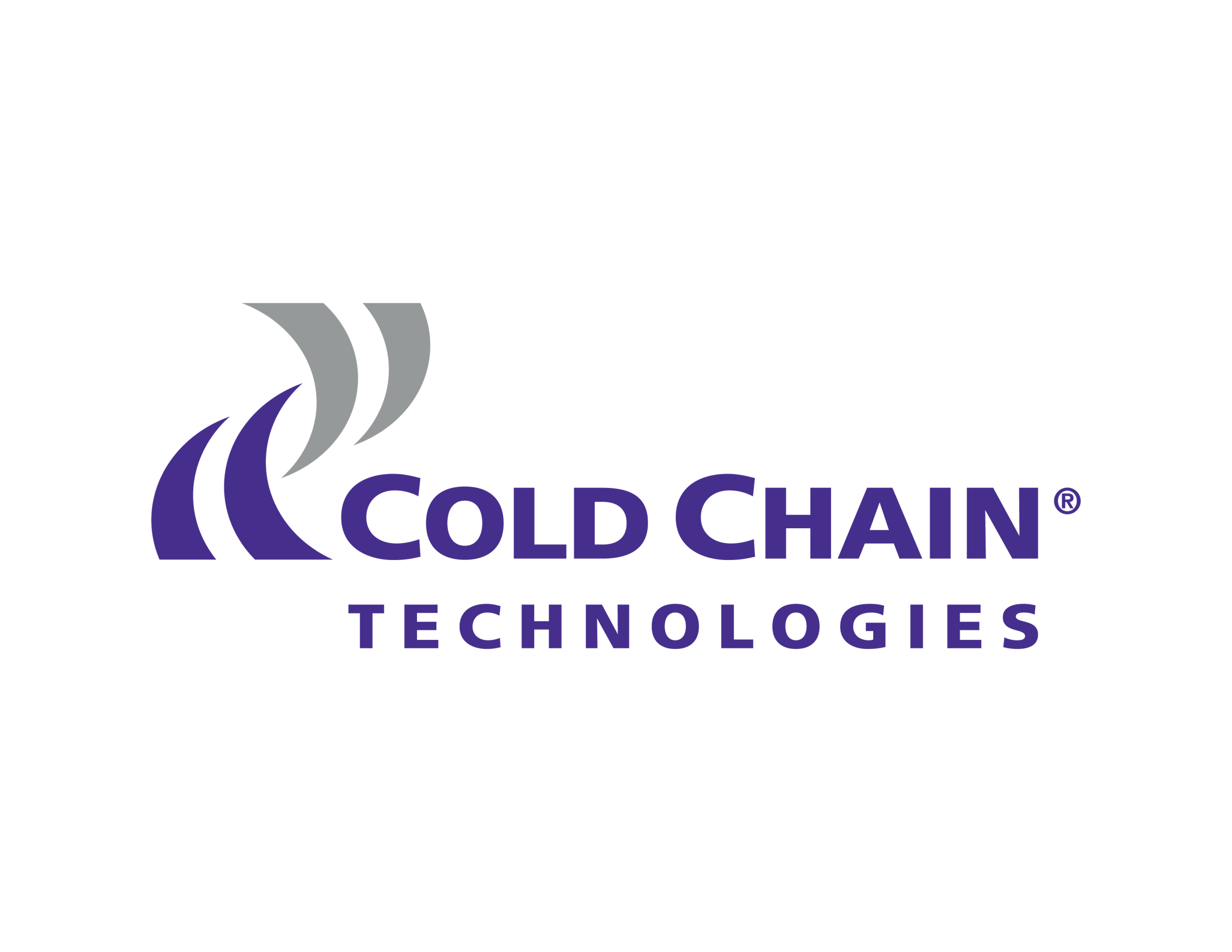Cold chain management is the management of all phases of the cold chain, including products in transit, in process, in storage, and in display.
Temperature-sensitive products rely on cold chain management for product efficacy, product safety, and adherence to relevant regulatory requirements. Products requiring cold chain solutions include pharmaceuticals, vaccines, biologics, lab samples, diagnostic materials, chemicals, food, and beverages.
Cold chain management is an essential component of the supply chain, integral to maintaining temperature ranges and air quality including carbon dioxide, humidity, and oxygen levels.
Any disruption or failure within the cold chain management process during transit, processing, storage, and display may result in product spoilage, loss, and financial implications. Maintaining the correct temperature and product environment is a critical success factor in the supply chain for everyone involved from the manufacturer, shipper, through to the end-customer.
Using the latest in thermal packaging technology and real-time temperature monitoring, the cold chain is maintained, monitored, adjusted, and tracked from manufacture through to delivery and display.
What is Cold Chain?
Cold chain is an uninterrupted flow of a specific thermal profile throughout the manufacturing, packaging, and distribution of a temperature-sensitive product.
Think of the cold chain as a temperature-controlled supply chain. A successful cold chain requires an unbroken and stable chain of refrigerated manufacture, production, packaging, transport, storage, and distribution.
Maintaining the cold chain demands knowledge and control of the shipping environment, package design, duration of the shipment(s), and critical control points throughout the process.
Did you know? The history of cold chain management dates to 1797 with British fishers using ice to preserve their catch. In 1938, American inventor Frederick Jones developed the first portable air-cooling unit for vehicles transporting perishable food. During World War II, these units were integral to the transport, preservation, and safety of blood, medicine, and food used at military hospitals and on the battlefield. The growth of the cold chain industry is linked to the Interstate Highway Act of 1956.
6 Reasons Why Cold Chain Management is Important
Integrity of Goods and Products
The safety, integrity, quality, and useability of goods and products depends on cold chain management. Modern cold chain management using the latest in thermal packaging, temperature tracking and monitoring, and storage helps ensure the safety, quality, and integrity of temperature-sensitive produc
Whether it’s keeping milk cold, ice cream frozen, or vaccines protected – cold chain management and logistics keeps the supply chain of vital goods and products operating smoothly. Your customers expect your products to arrive without bruising, discoloration, textural changes, bacterial growth, or worse. This is what cold chain management does for you and your customers.
Product Safety
Cold chain management keeps you out of the news headlines for the wrong reasons. No one wants to be making headlines for unsafe products and goods. Effective temperature control and monitoring means your standards and regulatory standards are met – keeping people safe.
24/7 monitoring of temperature, humidity levels, air quality, GPS location, energy use, delivery, and storage conditions, and more are key aspects of modern cold chain management.
Reducing Waste and Loss
One of the largest challenges of any supply chain is preventing product waste, damage, and loss. With cold chain management, products are monitored and tracked through-out every step of the cold supply chain. Companies depend on advanced thermal packaging, sophisticated refrigerants, reefers, cold chain parcel and pallet systems, temperature monitoring, and specialized insulated containers to protect and secure their goods and products.
With the tight margins and supply chain stressors, no company can afford the financial or reputational damage that comes with the trickle-down impacts of ruined temperature-sensitive products.
Improving Efficiency
Moving goods and products across the country and waterways is not a simple process. It’s costly, time-consuming, and can be inefficient. Because cold chain management uses integrated smart IoT-enabled tracking and monitoring, companies can streamline the transport, delivery, and storage of their products – helping to improve efficiencies and reduce costs.
Customer Service
Your B2B and B2C customers want your products and goods. But they expect these products to arrive on-time and adhering to high levels of quality and safety. Cold chain management and logistics gives you the insight and control over the distribution, storage, and delivery process required to meet customer expectations.
Cold chain management services such as Just in Time (JIT) delivery of thermal packaging supplies and a cold chain best practices GAP analysis ensure you and your customers benefit from an efficient, streamlined, and cost-effective cold supply chain.
Compliance and Regulatory Standards
Compliance with regulations governing the safe manufacture, transport, delivery, and storage of temperature-sensitive products is a must.
For example, the US FDA Food Safety Modernization Act (FMSA) rules are centered around the prevention of food contamination. These rules and those of the Sanitary Transportation of Human and Animal Food, outline regulations around in-transit temperature tracking requirements and data monitoring.
Additionally, the CDC has detailed guidelines for maintaining and managing the vaccine cold chain. These include recommended storage temperatures, vaccine storage requirements, and temperature monitoring.
It is essential companies are up to date with the latest FDA, CDC, Canadian, EU, and World Health Organization standards and regulations.
The cold chain management process includes the storage, packaging, tracking, transportation, customs clearance, product management, and delivery of products safely and securely.
The cold chain management process relies heavily on technology to monitor and maintain the temperature, logistics, movement, delivery, and security of temperature-sensitive products and goods.
- Storage: products such as insulated containers, vaccine and medical refrigerators and freezers, refrigerants, cold rooms/chillers are key to effective cold storage. Cold chain management starts with cold chain storage equipment and facilities.
- Packaging: when products leave storage facilities, cold packaging is vital to maintaining and monitoring temperature and security. Products such as cold chain parcel and pallet systems, refrigerant bricks, gel packs, gel bottles, and insulated containers and envelopes keep your products cold, improve transportation efficiencies, and prevent damage, waste, and loss.
- Tracking: data loggers and temperature indicators give companies, shippers, and their customers real-time temperature and GPS monitoring and tracking. This information is key to maintaining the cold chain, ensuring product quality and integrity.
- Transportation: the global supply chain means temperature-sensitive goods and products are moved around the world in a range of ways. Specialized cold chain vehicles such as refrigerated vehicles and reefer containers keep the cold supply chain moving across waterways, in the air, and along global/local roads and highways.
- Customs clearance: customs paperwork is a vital step in the cold supply chain, ensuring products can be transported and delivered quickly and efficiently. A failure to comply with customs clearance requirements can result in delays – causing product loss, risks to product quality, and additional expenses for storage, transport, and delivery.
- Product management: shipping supplies such as specialized cold parcels and pallets, insulated envelopes and containers and warehouse best practices with autonomous mobile robots and forklifts mean your products are moved and handled securely and safely within the cold chain.
- Delivery: ultimately delivering temperature-sensitive products and goods to your B2B and B2C customers depends on a finely tuned and streamlined delivery process. The cold chain management process includes documentation review, internal handling best practices, risk management, and securing compliant warehouse, storage, and display systems.
It would be ideal to include a graphic here. Thinking that this graphic could be used:
https://www.path.org/articles/vaccine-cold-chain-q/
Cold Chain vs. Supply Chain
Do you know these 4 differences between the cold chain and the supply chain?
Logistics: maintaining the cold chain requires deeper and broader logistics planning and management. For example, temperature-sensitive products cannot be let unattended in a delivery yard or waiting at customs clearance.
Specialized equipment: reefers, vaccine freezers and refrigerators, insulated pallets and containers, temperature, and data trackers – this equipment is standard practice for maintaining and supporting the cold chain.
Public health risks: when vaccines or food are not kept in temperature-controlled environments, the risks to public health are high. From food poisoning, food insecurity, through to unsafe vaccines and the risks in disease spread due to vaccine unavailability – the cold chain is imperative to public health and safety.
Documentation: regulations and compliance translate to extra paperwork and document verification. While the regular supply chain brings with it plenty of documentation, the additional regulatory standards from the FDA, DOT, CDC, WHO, EU, and others means the cold chain has additional documentation requirements.
These Temperature-Sensitive Products Need Cold Chain Management
Any product that is temperature sensitive needs cold chain management. These temperature-sensitive products need cold chain management:
- Vaccines including the COVID-19 vaccines from Pfizer and Moderna.
- Medical products including blood, biologics, insulin, and other medical devices.
- Wine requires consistent cool temperatures to prevent premature aging and loss of flavor.
- Frozen desserts including ice cream and gelato need to be kept frozen to prevent bacterial growth, crystallization, and loss of flavor.
- Perishable meat, seafood, and poultry is highly susceptible to bacterial growth when it is not kept below 40 degrees F or frozen at 0 degrees F.
- Fresh and frozen fruits and vegetables are at risk of skin damage, bacterial growth, flavor loss, bruising, and more when the cold chain is not maintained.
- Milk, milk alternatives, and dairy products including yogurt, oat milk, soy products, and fermented dairy all require cold chain management. As an example, milk must be processed, packaged, transported, and stored at below 45 degrees F to prevent bacterial growth.
Sign up for Cold Chain Tech blog updates to learn the latest about cold chain management, cold chain technology, and how the Cold Chain Tech team helps you maintain the integrity, safety, and quality of your temperature-sensitive products.


